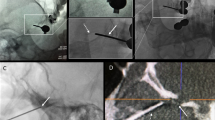Abstract
Purpose
Trigeminal neuralgia is the most common neurological cause for facial pain. Contemporary interventionl treatment relies on surgical microvascular decompression or, alternatively, percutaneous interventions targeting the semilunar ganglion via the foramen ovale. For the latter approach, only free-hand punctures using fluoroscopy devices have been reported. Therefore, the present study aimed to evaluate a new fluoroscopy-based guidance device for transforaminal puncture.
Methods
Two experienced examiners punctured the foramen ovale bilaterally free-hand, and using a guidance device in human cadavers (n = 9). The number of attempts for puncture was recorded. A new attempt was counted each time the needle had to be retracted for redirection.
Results
As compared to the free-hand puncture of the foramen ovale (4.44 ± 2.79), the new guidance device significantly reduced the number of trials needed (1.37 ± 0.69).
Conclusion
The employment of a guidance device facilitated percutaneous transforaminal puncture and resulted in a significantly decreased number of puncture attempts as compared to free-hand techniques in human cadavers.
Résumé
Objectif
La névralgie faciale est la cause neurologique la plus fréquente de douleur faciale. Le traitement interventionnel contemporain est fondé sur la décompression microvasculaire chirurgicale ou des interventions percutanées ciblant le ganglion semi-lunaire en passant par le foramen ovale. Pour cette dernière approche, seules des ponctions mains libres à l’aide de la fluoroscopie ont été publiées. La présente étude vise donc à évaluer un nouveau guidage fondé sur la fluoroscopie pour une ponction transforaminale.
Méthode
Deux examinateurs expérimentés ont fait une ponction bilatérale du foramen ovale avec mains libres, puis en utilisant un guide chez des cadavres humains (n = 9). Le nombre d’essais nécessaires a été noté. Un nouvel essai était compté chaque fois que l’aiguille devait être retirée pour être redirigée.
Résultats
Comparé à la ponction mains libres du foramen ovale (4,44 ± 2,79), le nouvel instrument de guidage a signifcativement réduit le nombre d’essais nécessaires (1,37 ± 0,69).
Conclusion
L’emploi d’un guide a facilité la ponction percutanée du foramen ovale et diminué signifcativement le nombre d’essais de ponctions en comparaison des techniques mains libres chez des cadavres humains.
Similar content being viewed by others
References
Zakrzewska JM. Diagnosis and differential diagnosis of trigeminal neuralgia. Clin J Pain 2002; 18: 14–21.
Platzer W, Putz R, Poisel S. New system for the preservation and storage of anatomical matter (German). Acta Anat (Basel) 1978; 102: 60–7.
Gomori JM, Rappaport ZH. Transovale trigeminal cistern puncture: modified fluoroscopically guided technique. AJNR Am J Neuroradiol 1985; 6: 93–4.
Gray H. Gray’s Anatomy, 20th ed. New York: Bartleby; 2000.
Gorge HH. Operative treatment of trigeminal neuralgia (German). Schmerz 2001; 15: 48–58.
Delzell JE Jr, Grelle AR. Trigeminal neuralgia. New treatment options for a well-known cause official pain. Arch Fam Med 1999; 8: 264–8.
Author information
Authors and Affiliations
Corresponding author
Rights and permissions
About this article
Cite this article
Hinteregger, M., Zschiegner, F., Lirk, P. et al. A new guidance device facilitates percutaneous puncture of the foramen ovale in human cadavers. Can J Anesth 51, 990–992 (2004). https://doi.org/10.1007/BF03018485
Accepted:
Published:
Issue Date:
DOI: https://doi.org/10.1007/BF03018485




